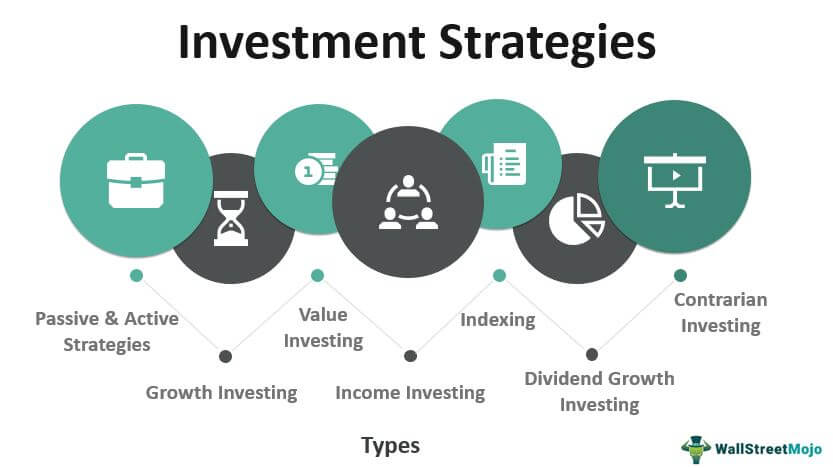Table Of Contents
What are Investment Strategies?
Investment strategies are strategies that help investors choose where and how to invest as per their expected return, risk appetite, corpus amount, long-term, short-term holdings, retirement age, choice of industry, etc. Investors can strategies their investment plans as per the objectives and goals they want to achieve.
Table of contents
- What are Investment Strategies?
- Investing strategies aid investors in deciding where and how to invest based on factors like projected return, risk tolerance, corpus size, long-term versus short-term holdings, retirement age, industry preference, etc.
- Investors can tailor their investing plans to the aims and objectives they hope to accomplish.
- Therefore, to reduce transaction costs, the passive method entails purchasing and keeping stocks rather than trading them regularly.
- Passive techniques tend to be less risky because they are believed to be incapable of outperforming the market due to their volatility.
Top 7 Types of Investment Strategies
Let’s discuss different types of investment strategies, one by one.

#1 - Passive and Active Strategies
The passive strategy involves buying and holding stocks and not frequently dealing in them to avoid higher transaction costs. They believe they cannot outperform the market due to its volatility; hence passive strategies tend to be less risky. On the other hand, active strategies involve frequent buying and selling. They believe they can outperform the market and can gain more returns than an average investor would.
#2 - Growth Investing (Short-Term and Long-Term Investments)
Investors chose the holding period based on the value they want to create in their portfolio. If investors believe that a company will grow in the coming years and the intrinsic value of a stock will go up, they will invest in such companies to build their corpus value. This is also known as growth investing. On the other hand, if investors believe that a company will deliver good value in a year or two, they will go for short term holding. The holding period also depends upon the preference of investors. For example, how soon they want money to buy a house, school education for kids, retirement plans, etc.
#3 - Value Investing
Value investing strategy involves investing in the company by looking at its intrinsic value because such companies are undervalued by the stock market. The idea behind investing in such companies is that when the market goes for correction, it will correct the value for such undervalued companies, and the price will then shoot up, leaving investors with high returns when they sell. This strategy is used by the very famous Warren Buffet.
#4 - Income Investing
This type of strategy focuses on generating cash income from stocks rather than investing in stocks that only increase the value of your portfolio. There are two types of cash income which an investor can earn – (1) Dividend and (2) Fixed interest income from bonds. Investors who are looking for steady income from investments opt for such a strategy.
#5 - Dividend Growth Investing
In this type of investment strategy, the investor looks out for companies that consistently paid a dividend every year. Companies that have a track record of paying dividends consistently are stable and less volatile compared to other companies and aim to increase their dividend payout every year. The investors reinvest such dividends and benefit from compounding over the long term.
#6 - Contrarian Investing
This type of strategy allows investors to buy stocks of companies at the time of the down market. This strategy focuses on buying at low and selling at high. The downtime in the stock market is usually at the time of recession, wartime, calamity, etc. However, investors shouldn’t just buy stocks of any company during downtime. They should look out for companies that have the capacity to build up value and have a branding that prevents access to their competition.
#7 - Indexing
This type of investment strategy allows investors to invest a small portion of stocks in a market index. These can be S&P 500, mutual funds, exchange-traded funds.
Investing Tips
Here are a few investing tips for beginners, which should be kept in mind before investing.
- Set Goals: Set goals on how much money is required by you in the coming period. This will allow you to set your mind straight whether you need to invest in long-term or short-term investments and how much return is to be expected.
- Research and Trend Analysis: Get your research right in terms of understanding how the stock market works and how different types of instruments work (equity, bonds, options, derivatives, mutual funds, etc.). Also, research and follow the price and return trends of stocks you chose to invest.
- Portfolio Optimization: Select the best portfolio out of the set of portfolios which meet your objective. The portfolio which gives maximum return at the lowest possible risk is an ideal portfolio.
- Best Advisor/Consultancy: Find yourself a good consulting firm or brokerage firm. They will guide and give consultation regarding where and how to invest so that you meet your investment objectives.
- Risk Tolerance: Know how much risk you are willing to tolerate to get the desired return. This also depends on your short term and long term goals. If you are looking for a higher return in a short period of time, the risk would be higher and vice versa.
- Diversify Risk: Create a portfolio that is a mix of debt, equity, and derivatives so that the risk is diversified. Also, ensure that the two securities are not perfectly correlated to each other.
Advantages of Investment Strategies
Some of the advantages of investment strategies are as follows:
- Investment strategies allow for diversification of risk in the portfolio by investing in different types of investments and industry based on timing and expected returns.
- A portfolio can be made of a single strategy or a combination of strategies to accommodate the preferences and needs of the investors.
- Investing strategically allows investors to gain maximum out of their investments.
- Investment strategies help reduce transaction costs and pay less tax.
Limitations of Investment Strategies
Some of the limitations of investment strategies are as follows:
- Average investors find it difficult to outperform the market. To earn an average return from investments, it may take them years, whereas professional investors would earn the same return in weeks or months.
- Even though a lot of research, analysis, and historical data are considered before investing, most of the decisions are taken on a predictive basis. Sometimes, the results and returns may not be as it was anticipated, and it may delay the investors from achieving their goals.
Frequently Asked Questions (FAQs)
Quantitative investment strategies, also known as quant strategies, are investment approaches that rely on quantitative analysis and mathematical models to make investment decisions. They involve vital elements, data analysis, quantitative models, risk management, and automated execution.
Bond investment strategies refer to approaches investors use to build and manage a portfolio of bonds. These investment strategies aim to achieve specific objectives, such as generating income, managing risk, or capital appreciation. Hence, the common bond investment strategies are buy-and-hold plans, yield curve strategies, duration management, credit quality strategies, and sector rotation.
Risk management is crucial in investment strategies. It involves assessing and mitigating various types of risks, including market, credit, and concentration risks. Diversification, asset allocation, and setting appropriate stop-loss limits are risk management techniques used to protect investments.
Conclusion
It is very important to have an investment strategy. It will help you rule out poor portfolios and will increase the chances of success. Ask yourself a few basic questions like how much I want to invest? How much return do I need? How much is my risk tolerance? What will be my investment horizon? Why did I need to invest? Etc. The clearer you are with your objectives, the better decision you will make regarding your investment. Always lookout for good opportunities and never invest at one go. Building a portfolio is like building a house brick by brick, money by money.

